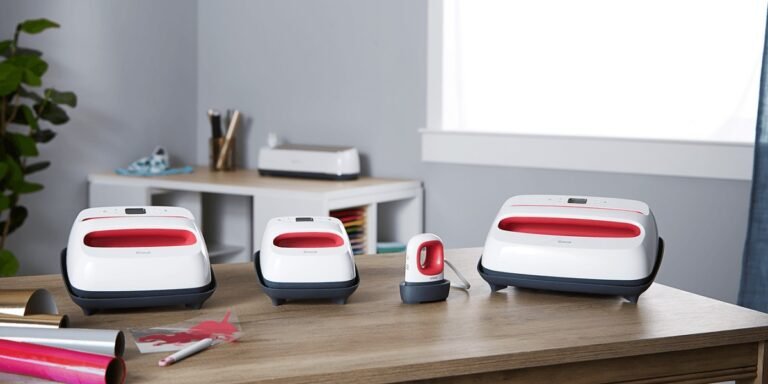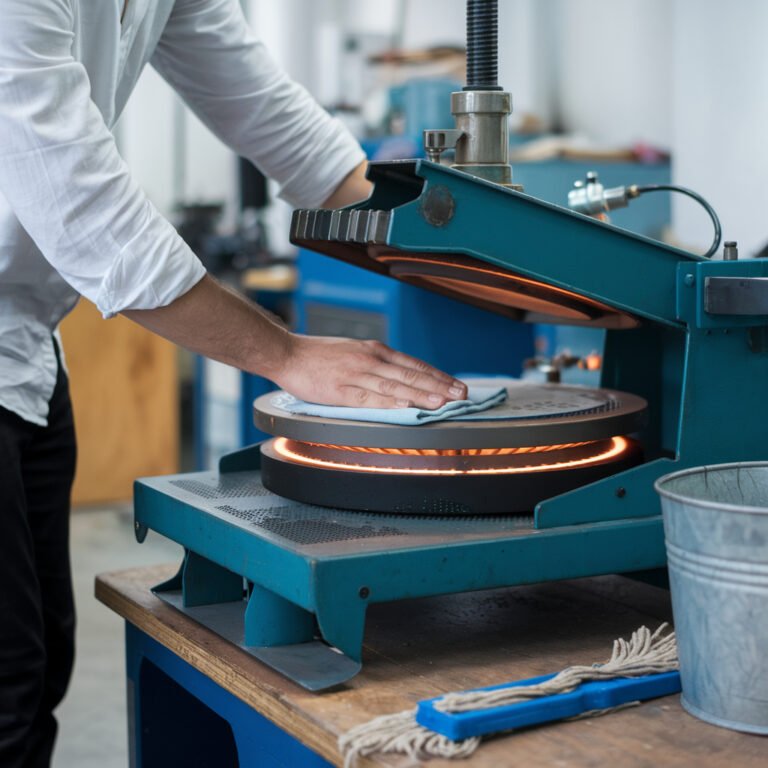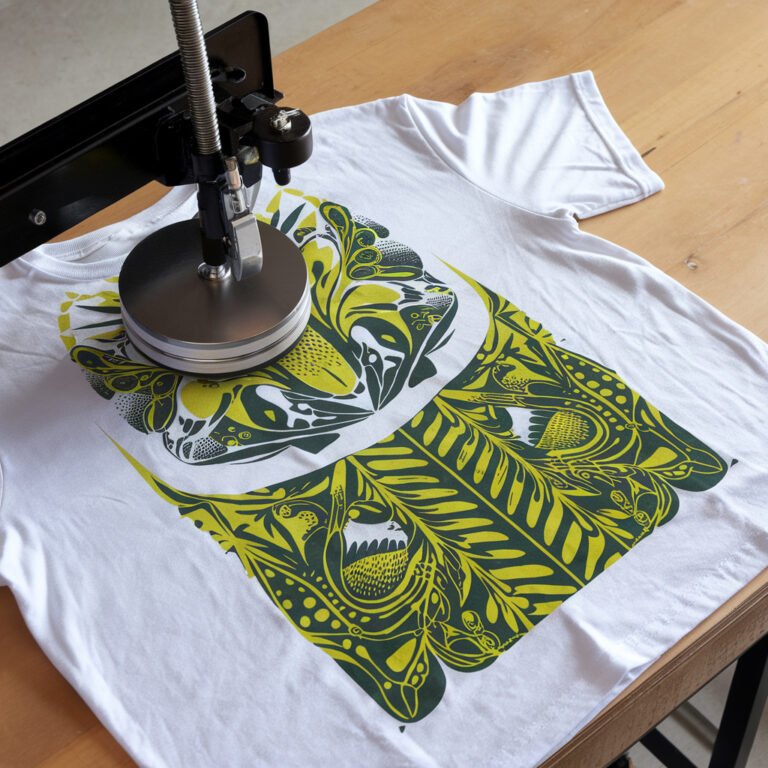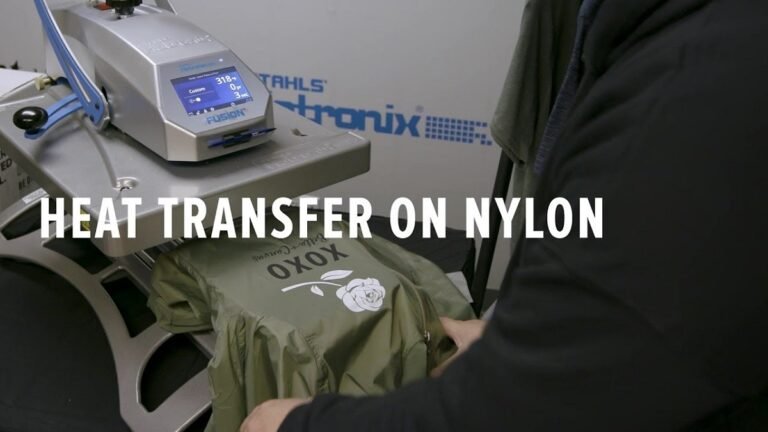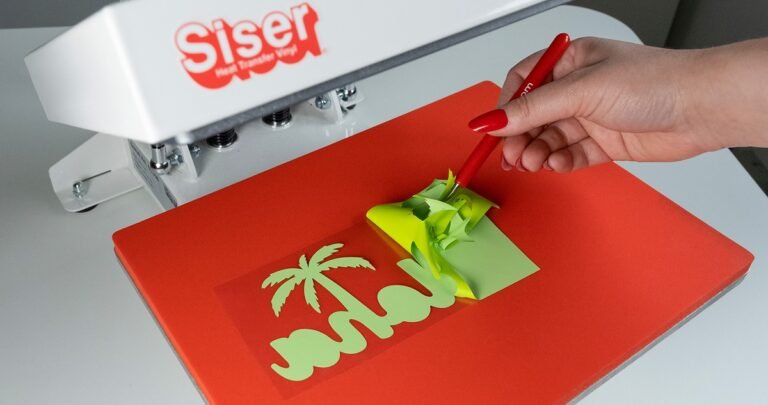Can You Use an Iron Instead of a Heat Press
Sure, you can use an iron instead of a heat press for small, occasional projects. It’s a budget-friendly and convenient option if you already own one. While an iron is perfect for customizing a few t-shirts or repairing items, it lacks the consistent heat and pressure of a heat press.
This might result in uneven application, especially for larger designs. With an iron, maintaining even pressure and moving it around is key for better results. It’s lightweight, easy to store, and great for personalizing on-the-go. But, to achieve professional results consistently, there’s more to know about each tool’s capabilities.
What Is a Heat Press?
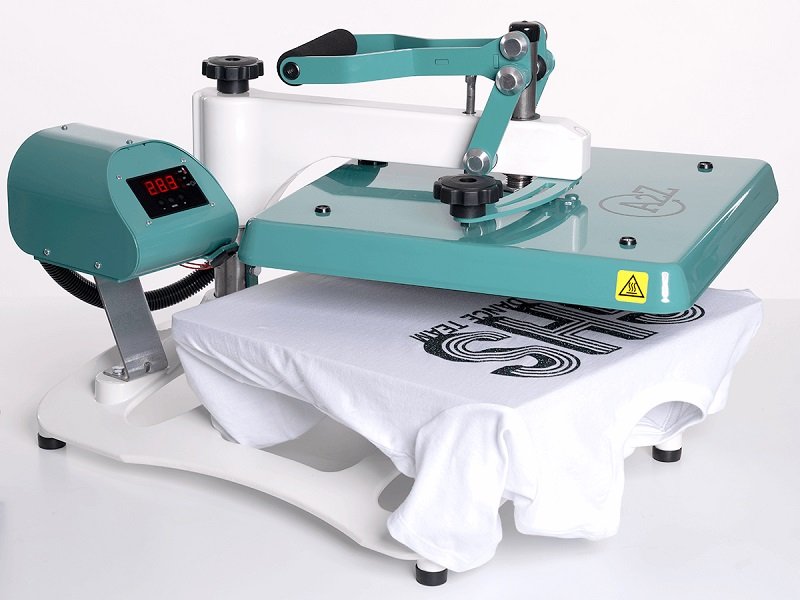
A heat press is a machine specifically designed to apply heat and pressure to transfer designs onto various materials. When you use a heat press, you’re looking at a tool that ensures even heat distribution and consistent pressure, which are crucial for achieving professional results.
It’s ideal for working with materials like fabric, ceramic, metal, and even wood. This machine is often utilized in creating custom t-shirts, mugs, hats, and more, offering flexibility in design and material choices.
In using a heat press, you’ll find that it operates with precision, allowing you to set specific temperatures and time durations tailored to each project. This specificity is key when working with different types of transfer papers or vinyl, which may require distinct settings to adhere properly. You’re in control of the entire process, ensuring that your design doesn’t peel, fade, or crack over time.
The heat press comprises a flat platen that heats up and applies pressure, typically featuring a digital display for easy monitoring. This makes it user-friendly, even if you’re new to the craft. Overall, a heat press is a reliable and efficient tool for all your design transfer needs.
Can You Use an Iron Instead of a Heat Press?
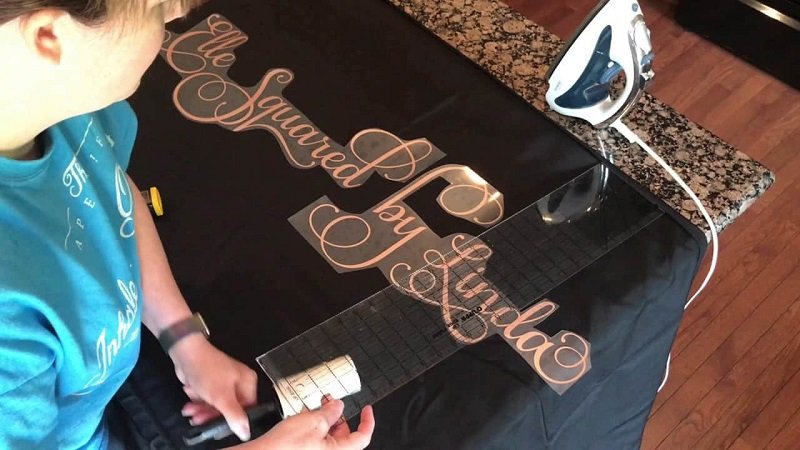
While a heat press offers precision and consistency, you might wonder if a household iron can achieve similar results for transferring designs. The good news is, you can use an iron to transfer designs, but there are some factors to consider.
A household iron lacks the uniform heat distribution and pressure control that a heat press provides. However, for small projects or occasional use, an iron can be a practical alternative.
When using an iron, here are some tips to enhance your results:
- Temperature Settings: Ensure the iron is set to the correct temperature for the material you’re working with. Most irons don’t have exact temperature gauges, so testing on a scrap piece first is wise.
- Pressure Application: Apply even pressure. Press down firmly and consistently, but remember that unlike a heat press, you’re manually controlling this aspect.
- Time Management: Adhere to recommended pressing times. An iron may require slightly longer pressing times than a heat press.
- Surface Area: Since irons cover less area, you may need to move it around for larger designs, risking uneven results.
- Material Type: Some materials might not work well with an iron, so verify compatibility before starting.
These considerations will help ensure your designs transfer effectively using a household iron.
How Does an Iron Work for Heat Transfer?
To get started with using an iron for heat transfer, you’ll need to understand how it generates and distributes heat across its soleplate to adhere designs onto various materials. An iron works by converting electrical energy into heat, which then spreads evenly across the metal soleplate.
This heated surface is what you’ll use to press designs onto fabric. When you apply pressure with the iron, the heat activates the adhesive on transfer paper or vinyl, causing it to bond with the fabric surface.
The temperature settings on the iron allow you to control the heat level, which is crucial because different materials require different heat intensities. For instance, cotton can handle higher temperatures, while synthetic fabrics need a gentler approach to prevent damage. Make sure to adjust the iron’s settings based on the material you’re working with.
Moreover, it’s essential to move the iron around to ensure even heat distribution and prevent scorching. You should also apply firm, even pressure to ensure the design adheres properly. While an iron isn’t specifically designed for transfers, with the right technique and care, it can be an effective tool for small projects.
Heat Press vs. Iron: Key Differences
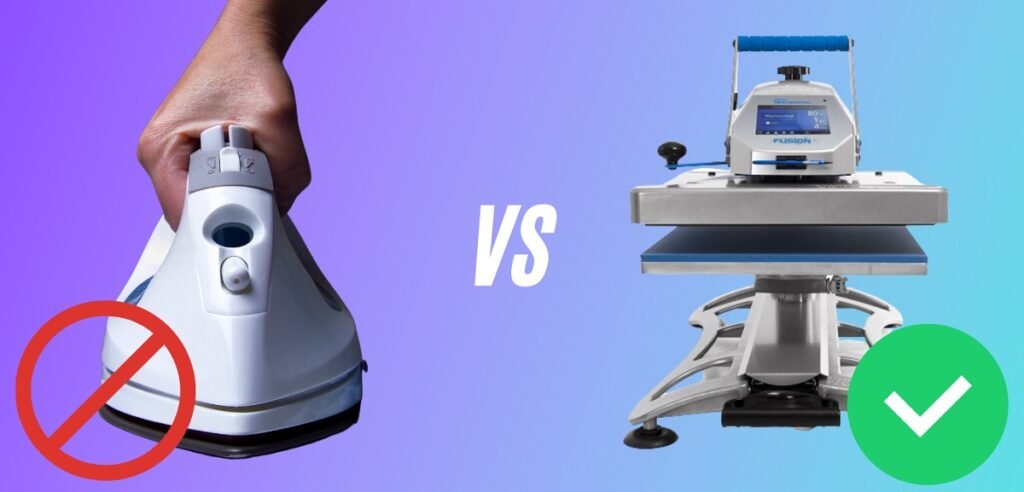
When you’re deciding between a heat press and an iron for your projects, consider the key differences in heat distribution, pressure application, size, and efficiency. A heat press offers even heat distribution and consistent pressure, covering larger areas quickly and efficiently.
On the other hand, an iron requires more manual effort to ensure even results, which might affect the overall quality and time spent on your work.
Heat Distribution
Unlike an iron, a heat press distributes heat evenly across its entire surface, ensuring consistent application for optimal results. This even heat distribution is crucial when you’re working on projects that demand precision, like transfers and sublimation. With a heat press, you don’t have to worry about any cold spots that might ruin your design.
On the other hand, an iron can be unpredictable in terms of heat distribution. Its soleplate might not always cover the entire area you’re working on, causing uneven results. Here are some key differences in heat distribution between a heat press and an iron:
- Surface Area: A heat press typically has a larger surface area, allowing it to cover more ground than an iron in one go.
- Temperature Consistency: Heat presses maintain a consistent temperature, while irons can fluctuate, especially when moved.
- Design Purpose: Heat presses are designed for uniform heat application, whereas irons are meant for varied tasks.
- Manual Movement: When using an iron, you have to move it around manually, which can lead to uneven heating.
- Heat Settings: While irons have general settings, heat presses allow for precise temperature control tailored to specific materials.
Understanding these differences can help you make an informed decision for your projects.
Pressure Application
A heat press applies consistent pressure across the entire surface, unlike an iron where pressure depends on your hand’s steadiness. When using an iron, you have to manually adjust the pressure, which can lead to uneven results.
This inconsistency might cause some areas to transfer well while others don’t, affecting the overall quality of your design. It’s challenging to maintain even pressure with an iron, especially over larger areas, as it requires continuous focus and effort.
With a heat press, you set the desired pressure level, and the machine does the rest for you. This ensures uniform pressure across the whole design, leading to a more professional and durable finish. Additionally, heat presses are designed to balance the pressure evenly, so there’s no need to worry about pressing harder in certain spots.
Using an iron for pressure application can be tiring and time-consuming. You might find yourself repeatedly adjusting your grip and position to achieve the desired outcome. In contrast, a heat press allows you to work efficiently and consistently, saving time and energy. If you’re aiming for high-quality results, the pressure consistency of a heat press is unmatched.
Size and Coverage
One major difference between a heat press and an iron is the size of the surface they can cover, impacting how efficiently you can complete larger projects. With a heat press, you have a consistent and wide surface area to work with, allowing you to press large designs or multiple smaller items at once.
This makes it particularly convenient if you’re working on bulk orders or sizable designs. On the other hand, an iron has a much smaller surface area, which means you’ll need to move it around to cover the entire design, increasing the time and effort required for larger projects.
When considering the size and coverage of each option, keep in mind:
- Heat Press Coverage: Offers a larger pressing area, often up to 16×24 inches or more.
- Iron Coverage: Typically limited to the iron’s soleplate, which is much smaller.
- Consistency: Heat presses provide even heating across the entire surface.
- Edge-to-Edge: A heat press can cover entire sections without missing spots.
- Usability: Easier to handle large projects with a heat press due to its size.
These factors significantly affect how you approach projects, especially when dealing with larger or more complex designs.
Efficiency
When evaluating efficiency, you’ll find that a heat press typically outperforms an iron due to its consistent temperature control and ability to handle larger areas quickly. A heat press maintains a uniform temperature across its surface, ensuring that each design is pressed with precision.
This consistency means you won’t have to worry about uneven heating, which can lead to inconsistent results or even damage to your materials.
In contrast, an iron requires constant attention; you’ll need to manually adjust the temperature and pressure, often leading to variations that affect the final outcome. Plus, the smaller surface area of an iron means it takes longer to cover larger designs, increasing the risk of mistakes like scorching or incomplete transfers.
Moreover, a heat press applies even pressure across the entire design, which is crucial for achieving professional-grade results. With an iron, you apply pressure manually, making it difficult to achieve the same level of consistency and detail.
If you’re working with intricate designs or large batches, the time you save with a heat press can be significant. Ultimately, if efficiency is your priority, investing in a heat press is a wise decision for quality and speed.
Advantages of Using a Heat Press
With a heat press, you can achieve consistent and professional results that are often difficult to replicate with an iron. A heat press is specifically designed for tasks like transferring designs onto fabrics, which means it’s equipped to handle the job with ease and precision.
Unlike an iron, which can struggle to maintain consistent heat and pressure, a heat press ensures that every square inch of your material receives the same treatment, resulting in vibrant and durable transfers.
Here are some advantages of using a heat press:
- Even Pressure Distribution: A heat press applies uniform pressure over the entire design, ensuring every part adheres properly.
- Consistent Temperature: It maintains a steady temperature throughout the process, reducing the risk of scorching or uneven transfers.
- Time Efficiency: Heat presses are faster, completing transfers in seconds, which is invaluable for large projects.
- Versatility: They’re capable of working with a variety of materials beyond just fabric, like ceramics and metal.
- Professional Finish: The results are clean and professional, often making your projects look store-bought.
Advantages of Using an Iron
While a heat press offers professional-grade results, using an iron can be a convenient and budget-friendly alternative for smaller projects and beginners. You might not get the same precision, but an iron is versatile and easy to use. It’s perfect for personalizing T-shirts, tote bags, or small crafts without needing specialized equipment. Plus, you probably already have an iron at home, which means no extra cost.
When you’re just starting out, an iron’s simplicity can be a real advantage. It allows you to experiment with different materials and techniques without the pressure of investing in something more complex. You can practice your skills on small batches before deciding if you want to upgrade to a heat press someday.
Here’s a quick comparison to help you understand the benefits:
| Advantage | Description |
|---|---|
| Cost-effective | No need to buy a new device if you already own an iron. |
| Easy to store | Irons are compact and fit easily in most storage spaces. |
| Portable | Lightweight and easy to carry, ideal for crafting on-the-go. |
| Beginner-friendly | Simple operation makes it accessible for newcomers to crafting. |
Using an iron might just be the accessible, flexible option you’ve been looking for.
When Is It Okay to Use an Iron?
For small-scale projects and quick fixes, you’ll find using an iron perfectly acceptable. It’s a handy tool when you’re working on a few items or need a fast solution without investing in more specialized equipment. An iron works well for situations where precision and efficiency aren’t the top priority. Here are some scenarios where using an iron is fitting:
- Personal Projects: Crafting a custom t-shirt for yourself or a friend? An iron is just fine for these one-off endeavors.
- Small Batches: If you’re creating a handful of items, like baby onesies or tote bags, you can efficiently use an iron without hassle.
- Repairs and Adjustments: Fixing a peeling transfer or adjusting a small design doesn’t require the full power of a heat press.
- Limited Space: If you don’t have space for a heat press, an iron is a compact alternative that fits easily in any storage.
- Budget Constraints: When funds are tight, an iron offers a cost-effective way to get started with heat transfer projects.
Keep in mind that an iron can be your go-to tool for these straightforward tasks, making it a practical choice for many DIYers.
When Should You Invest in a Heat Press?
Once your projects grow in scale or complexity, it’s time to consider investing in a heat press for more consistent and professional results. A heat press offers precise temperature and pressure control, ensuring that each transfer adheres perfectly to the fabric. This is crucial when you’re doing larger batches or working with intricate designs that require uniform application.
If you find yourself spending too much time with an iron, or if you’re struggling with uneven transfers, a heat press can save you time and frustration. It’s particularly beneficial if you’re running a small business or planning to sell your creations. Customers expect high-quality finishes, and a heat press helps meet those expectations consistently.
Additionally, a heat press is more versatile than an iron. It can handle various materials, from t-shirts to caps, and even tote bags, expanding your creative possibilities. The ability to set exact temperatures and pressure levels means you can work with specialty vinyl and heat-sensitive materials without worry.
In short, if you’re serious about your craft or business and want to enhance efficiency and quality, investing in a heat press is a smart move. You’ll notice the difference in both productivity and end results.
Step-by-Step: How to Use an Iron for Heat Transfer
To successfully use an iron for heat transfer, start by gathering all necessary materials, including your iron, transfer paper, and the fabric you’ll be working on. Ensure your iron has a clean, smooth soleplate and can reach the temperature recommended by your transfer paper’s instructions. Prepare your workspace by ensuring it’s flat and heat-resistant.
Before you begin, pre-wash the fabric to remove any sizing or treatments. This helps the transfer adhere better. Once ready, follow these steps:
- Preheat the Iron: Set it to the cotton or highest setting without steam.
- Prepare the Fabric: Lay the fabric flat and iron it to remove wrinkles.
- Position the Transfer: Place the transfer paper design-side down on the fabric.
- Apply Heat: Firmly press the iron onto the transfer, applying even pressure. Hold for the time specified by the transfer paper instructions.
- Peel the Paper: Let it cool slightly, then carefully peel away the backing paper.
After completing the transfer, let the fabric cool completely to set the design. Ensure you follow the care instructions for your finished item to maintain the transfer’s quality. With practice, using an iron can yield fantastic results.
Frequently Asked Questions
What Materials Can Be Used With Both an Iron and a Heat Press?
You’re probably wondering what materials work with both an iron and a heat press. Well, you can use cotton, polyester, and blends of these fabrics for most transfers. Vinyl, especially heat transfer vinyl (HTV), is another material that’ll work well.
Flocked vinyl, sublimation prints, and even some types of transfer paper are compatible too. Just remember to check each material’s heat tolerance to avoid any mishaps during the process.
How Long Does It Take to Iron a Design Onto Fabric?
When ironing a design onto fabric, you’ll usually spend around 3 to 5 minutes per section. It depends on the fabric type and the design’s complexity. Make sure you apply firm pressure and maintain consistent heat. Check the instructions on your transfer paper for specific timing.
Don’t rush—take your time to ensure every part of the design adheres properly. This will help achieve a clean, professional look.
Are There Specific Temperature Settings for Different Materials?
When you’re working with different materials, it’s crucial to know the specific temperature settings. Cotton, for instance, can handle higher heat, around 400°F, while delicate fabrics like polyester need lower temperatures, around 275°F.
Always check the material’s care label and adjust your settings accordingly. If you’ve got a temperature guide or chart, it’ll make your life easier. Remember, setting the right temperature prevents damage and ensures a perfect finish.
Can Using an Iron Damage Certain Types of Fabric?
Using an iron can indeed damage certain fabrics if you’re not careful. Delicate materials like silk or polyester might scorch or melt under direct heat. Always check the fabric’s care label for recommended temperatures. If the iron’s too hot, it could cause discoloration or damage. To avoid mishaps, test on a small, hidden area first and consider using a pressing cloth to protect your fabric from direct contact.
What Safety Precautions Should Be Taken When Using an Iron for Heat Transfer?
When using an iron for heat transfer, you should ensure you’re working on a stable, heat-resistant surface to avoid accidents. Always keep your fingers away from the iron’s hot plate, and never leave it unattended while plugged in.
Use protective gloves if necessary and double-check that the fabric can withstand the iron’s temperature. Make sure to unplug the iron immediately after use to prevent any potential hazards.
Conclusion
In conclusion, while you can use an iron for heat transfers, it’s not always the ideal choice. An iron is suitable for small projects or occasional use due to its convenience and accessibility. However, if you’re looking for consistent, high-quality results, especially for larger or frequent projects, investing in a heat press is worth considering.
It offers even pressure and temperature, ensuring professional-grade finishes. Assess your needs and choose the tool that best suits your crafting goals.

